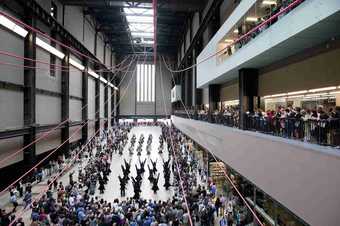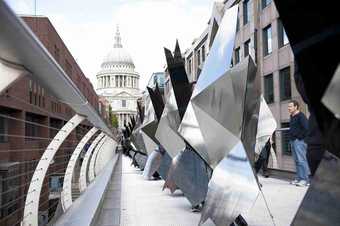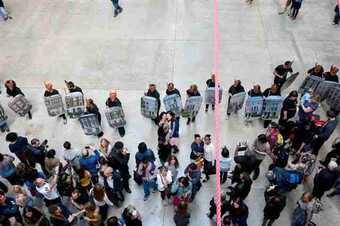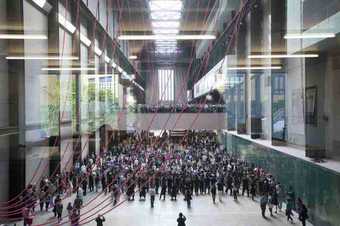Coinciding with the Notting Hill Carnival, Tate Modern presents Up Hill Down Hall: An indoor carnival, a new performance commission guest curated by Claire Tancons that offers critical and artistic perspectives on Carnival.
Informed by the history of the Notting Hill Carnival as it reaches a milestone half-century of existence, Up Hill Down Hall offers critical and artistic perspectives on Carnival with performances for hundreds of participants by artists Hew Locke and Marlon Griffith against the backdrop of an architectural design by Gia Wolff and a soundscape by Dubmorphology (Gary Stewart and Trevor Mathison) with a special intervention by Central Saint Martins Fine Arts students and recent graduates.
Up Hill Down Hall engages with Carnival as ritual of resistance, festival of otherness and performance art, and with the Notting Hill Carnival specifically as a contested site from which to reflect on notions of public space, performance and participation. It conceives of Carnival less as a theme than a medium and introduces practitioners across disciplines who draw from Carnival as a medium of artistic production and a form of social and political address.
London-based artist Hew Locke creates his first performance work, Give and Take, an exploration of the changing spatial politics of the Notting Hill neighbourhood. Give and Take both critiques the gentrification of the area and embraces the Brazilian influence on this historically pan-Caribbean festival. A piece about the tensions between residents and street revelers it asks ‘Who owns the streets of Notting Hill?’
Locke’s first carnival-inspired performance is the outcome of decade-long meditations on Carnival in Guyana and London and continued engagement with carnival aesthetics that have long suffused his work. Give and Take is realised in collaboration with the Batala Samba-Reggae band.
Trinidad-born, Japan-based visual artist Marlon Griffith presents No Black in the Union Jack, a performance inspired by the 2011 London summer riots. In this piece, Griffith fuses the nationalistic Caribbean motif of the humming bird with anti-riot police shields in body adornments that blur the boundaries between masquerader and police officer. Also a trained masman – the Trinidadian colloquial for Carnival designer – Marlon Griffith has a longstanding experience in creating carnival performances both for the Trinidad and Notting Hill carnivals. Griffith is collaborating with Elimu Paddington Arts Mas Band for which he designed two carnival bands in the past.
Inspired by extensive student research into the socio-political history of the Notting Hill Carnival and the politics of space and location, The Sky is Dancing is a special intervention that responds to wider critical debates about public art and ceremonial practices that have influenced and been influenced by carnival as a cultural and artistic form.
The Sky is Dancing project has been produced under the auspices and with the participation of UAL’s joint Chairs of Black Art and Design, Sonia Boyce and Paul Goodwin in collaboration with Anne Eggebert and Stephen Carter of the XD Pathway at CSM.
London-based sound artists Dubmorphology remix live and recorded tracks of steel pan and calypso, reggae and punk with texts relating to the Notting Hill Carnival from Linton Kwesi Johnson to Zadie Smith, and elements from Gary Stewart’s ongoing oral history archive of the Notting Hill Carnival. The live remix, entitled Sonar, is played through a customised sound system on the bridge that crosses the Turbine Hall, alluding to sound system set ups under the Westway Bridge during Notting Hill Carnival.
Using Oscar Niemeyer’s carnival stadium in Rio de Janeiro, the world-famous Sambadrome, as reference, New York-based architectural designer Gia Wolff transforms Herzog & DeMeuron’s architectural space of the Turbine Hall into a carnival space with Canopy. A deconstructed canopy of ropes hung above and under the Turbine Hall bridge, the monumental installation enhances the Turbine Hall’s unique street-wide scale and entices processional performance.
While signalling the importance of Carnival as a performance medium with mass appeal in the culminating era of the massification of museum culture, Up Hill Down Hall inscribes these works within the politically conscious cultural legacy of the Notting Hill Carnival, born of Caribbean migration and metropolitan accommodation to the aftermath of colonialism, resistance to racism and the mainstreaming of multiculturalism and, ultimately, developed through cultural ingenuity and artistic creativity at the forefront of the formation of postcolonial British culture.
Read the full curatorial statement [PDF, 35 Kb]
This film file is broken and is being removed. Sorry for any inconvenience this causes.
BMW Tate Live: Up Hill Down Hall: An Indoor Carnival
Biographies
Dubmorphology
Dubmorphology is a London based interdisciplinary artist and research group formed by Gary Stewart and Trevor Mathison. Through experimental approaches to sound art, live cinema and installations Dubmorphology blur the boundaries between the sonic, visual and performative. It’s practice is distinguished by it’s ongoing investigation into the unique spaces emerging in museums, art galleries and public spaces formed by the shifting intersections between audiences, authorship and participation. Recent exhibitions, biennials, laboratories and performances include Uprising, Bogota; Multiplicidade, Rio de Janerio; Haus der Kulturen der Welt, Berlin; Art Dubai, Madinat Jumeirah; Taipei Biennial; W.E.B. Dubois Institute, Cambridge; Afterimage, Bristol; and dOCUMENTA (13), Kassel.
Marlon Griffith
Marlon Griffith began his artistic practice as a Carnival designer—a “mas’ man,” as Trinidadians would call him. This background deeply shapes his work as a contemporary visual artist, which has performative, participatory, and ephemeral characteristics that derive from Carnival. Griffith has shown internationally including South-South: Interruptions & Encounters, Toronto, 2009; Global Caribbean, Miami, 2010; Wrestling with the Image: Caribbean Interventions, Art Museum of the Americas, Washington 2011; 7th Gwanju Biennale, South Korea, 2008; CAPE09, Cape Town, 2009; Manifesta 9 Parallel Projects, 2012 and AichiTrienniale, Japan, 2013. In 2010 Griffith was the recipient of a John Simon Guggenheim Fellowship and of a Commonwealth Award.
Hew Locke
Hew Locke is an artist who explores the subject of power, particularly through the representation of royal portraiture, coats-of-arms, public statuary, trophies, weaponry and costume. Drawing on the dynamic society of Guyana, the wider Caribbean and Europe, Locke delves deeply into the history behind the subject matter and objects involved in his work to create pieces that stand on a crossroad of cultures, mediums and historic references. Locke has exhibited both nationally and internationally including the National Portrait Gallery, Tate Britain, Victoria & Albert Museum and British Museum in London, New York Museum of Art and Design, Atlanta Contemporary Arts and at Brooklyn Museum, New York as well as the Pérez Art Museum, Miami. This year he will be taking part in Prospect.3, New Orleans and the Kochi-Muziris Biennale, India.
Claire Tancons
Claire Tancons is a curator, writer and scholar based in New Orleans whose work focuses on Carnival, public ceremonial culture, civic rituals and popular movements. Often curating for biennials (Prospect. 1 New Orleans, 7th Gwangju Biennale, CAPE09, Biennale Bénin, 7th Göteborg Biennial) Tancons has developed alternative genealogies and methodologies for thinking and presenting performance, including reclaiming the processional as a curatorial medium. She recently initiated a series of collaborations including Far Festa: Nuove Feste Veneziane (IUAV University and Bevilacqua La Masa Foundation, Venice, 2013), En Mas’: Carnival and Performance Art of the Caribbean (Contemporary Arts Center New Orleans and Independent Curators International, New Orleans, 2014-2015) and Psychic Pageant (New Orleans Airlift, New Orleans, 2014). Tancons received many grants from the Andy Warhol Foundation, the Prince Claus Fund and the Foundation for Arts Initiatives among others and, in 2012, an Emily Hall Tremaine Exhibition Award.
Gia Wolff
Gia Wolff is an architectural designer who is interested in architecture that embodies a reciprocal relationship between the user and the built environment and questions the performative aspects of the discipline. In 2013, Wolff was winner of the Wheelwright Prize for her project, Floating City: The Community-Based Architecture of Parade Floats, where she currently studies the traditions of parade floats—elaborate temporary and mobile constructions that are realized annually in various carnivals and festivals around the world. She is presently an adjunct professor at the Pratt Institute, School of Architecture, New York and an assistant professor at the Irwin S. Chanin School of Architecture at the Cooper Union, New York.
Credits
Up Hill Down Hall: An Indoor Carnival is curated by Claire Tancons in discussion with Tate Modern’s curatorial team and in collaboration with the artists in the project with support by students and recent graduates from BA Fine Art at Central Saint Martins, UAL: University of the Arts London, along with members from the Notting Hill Carnival Community including participants and volunteers from Elimu Paddington Arts Mas Band and Batala Samba-Reggae percussion band.
No Black in The Union Jack by Marlon Griffith was choreographed by the artist, Sophie Connon, Khisha Clarke, Cleo Lake and Shahnee Taylor-Brown. Performed by Theo Calvin, Ibiye Camp, Mimi Chu Leung, Khisha Clarke, Sophie Connon, Guler Ergun, Moe Farah, Marina Flores, Julia Frank, Filipa Guimarães, Beverley Heath, Sandra Helk, Ra Hendricks, Jenna Jones, Piotr Koziel, Cleo Lake, Sara MacQueen, Chris Pak, Donna Philip-Foare, Suresh Rambaran, Jordan Roberts, Andrew Roy, Pawel Skoneczny, Aidan Strudwick, Nina Suwala, Shahnee Taylor-Brown, Carrita Thornton, Veronica White, Eilene Wilson, Malaika Wong and Sally Wood.
Give and Take by Hew Locke received additional support from Contemporary Arts Center New Orleans, as part of En Mas’: Carnival and Performance Art of the Caribbean. The exhibition, which will open in 2015, is curated by Claire Tancons and Krista Thompson at the Contemporary Art Center (CAC),New Orleans and co-organized as a travelling exhibition by Independent Curators International (ICI),New York. The exhibition is made possible by an Emily Hall Tremaine Exhibition Award with additional support from The Andy Warhol Foundation for the Visual Arts. Performed by Batala Samba-Reggae Band.








